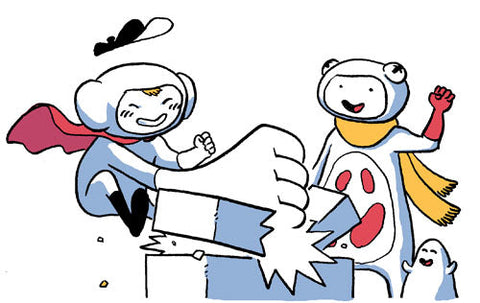There is no single leadership attribute that trumps the rest in terms of value.
But if there was, it would be the ability to create psychological safety.
Good news: anyone can learn this skill. All it takes is a little understanding and a few tried-and-tested tactics - and we’ve got both.
Before we start, ask yourself a question:
What happens when someone on your team makes a mistake?
The answer to this question can tell you a lot about your team dynamics. The answers largely fall into two categories:
- You’re not sure because they don’t tell you, or if they do - bad things happen!
- You get to the bottom of how/why it happened and work together to create a solution.
And the one ingredient that decides which of those categories your team falls into?
Psychological safety.
What is psychological safety?
Psychological safety is the idea that you won’t get punished for making a genuine mistake.
It’s a powerful thing, this psychological safety. It’s vital for:
- Honest communication
- Comfort at work
- Creativity and idea generation
- Relationship building
All things that add up to create a productive and happy workplace.
Here’s a little scenario to help illustrate the notion.
You’ve got two teams of people working together to solve a problem. Say, seeing who can build the tallest tower out of the materials provided. The winning team gets a cash prize!
Team A are told that every time one of their efforts collapses, 10% of the prize money gets taken away. Team B are told that even if they fail, they’ll get a token prize for taking part.
Which team do you think is going to work together the best? Team A, who have to worry about the shame of costing the team money if their idea causes a collapse? Or Team B, who can suggest wacky ideas (that just might work) and take a ‘fail fast, fail often’ approach?
Now apply the same logic to work. Who works best when they know their job - their income - is at stake?
In fact, psychological safety is a basic requirement even in animals.
Recent studies into dog training shows that the use of punishment-based training methods is correlated with reduced performance and playfulness and increased fearfulness, and also correlates with problematic behaviour. Now, people aren't dogs - but it's telling that punishment can have such a profound effect even on non-humans.
So psychological safety is more than the freedom to make mistakes; it’s freedom to play, to be creative, to try new things and to think outside the box. All things that can add up to a huge competitive advantage. And with many industries experiencing a talent shortage, it doesn’t hurt to have a company culture worth shouting about, either.
Additionally, you can’t have an inclusive culture without psychological safety. All of those great things we talked about above - playfulness, creativity - require people to feel comfortable with being their authentic, unique selves. Psychological safety is the bedrock of an inclusive organisation.
How do you create psychological safety?
Alas, it’s not as simple as letting everyone know that they won’t be punished for making mistakes.
But there are some simple tried-and-tested methods that will help you embed psychological safety in your team culture. It can be built into processes, particularly, so that the way you work is ‘safe’, not just the way you communicate. You can see this in action when you look at Toyota’s ‘Andon Cord’, a simple mechanism that uses a consistent and predictable process that includes praise and collaborative problem solving to ensure issues get reported and resolved every time.
Foundations of psychological safety
There are some behaviours that you can master that will nurture psychological safety in your team. One is active listening, and learning more about how body language and your go-to responses in conversations can be adjusted to be more encouraging. Another is the act of openly sharing about yourself. You’ll see more about that in the ‘Share often’ section, below. And another is ensuring your whole team communicates in an inclusive way by championing that type of communication yourself. Don’t interrupt, include everyone in the conversation and ensure that your team does the same.
Keen to get started with some actual strategies? Here’s a walk-through of Dave Cunningham’s (Author of Team Tactics) recipe for psychological safety.
Have meaningful one-to-ones
One-to-one meetings are not about projects and performance. They’re about getting to know your team and supporting them to reach their full potential and achieve their goals. The One-to-one tactic will guide you through this process (and you can also read our extensive guide to one-to-one meetings).
Learn how your team members work best
We’ve all got our own rhythms, practices and preferences when it comes to work. The My User Manual tactic helps you understand your team members’ individual working patterns, feedback preferences and personal goals. You can use that information to support them, and to find ways for everyone on your team to work together harmoniously.
Share your user manual with each person, too - showcase the measures you have put in place to ensure you do your best work.
Create opportunities to try new things
Give your team permission and opportunities to get out of their comfort zone and try things they’re interested in, even if they fall outside of their remit at work. The Community of Practice tactic guides you through setting up these opportunities and getting buy-in to ensure that it’s not just your team getting involved. The output? Shared knowledge, development opportunities and new ways of thinking.
Boost the impact of this by getting involved yourself - join a group to learn about something you haven’t got experience in. Seeing managers willing to learn from others and getting stuck in is a powerful leveller.
Share often
We’ve saved the most powerful tactic for last. Daily Sharing allows your team to quickly share what they’re working on without onerous stand-ups at the start of every day.
And if you want to supercharge your psychological safety? Share your own mistakes. So when you’re asked “What are you working on?” you can say “I missed a meeting yesterday, so right now I am catching up on the minutes and working out if there is any value I can add after the event before cracking on with the actions against my name.”
Psychological safety works both ways
By creating a safe environment, you also get to enjoy working in it! And you can feel at ease knowing that your team will come to you with any problems they have - even if it’s caused by a mistake they (or you!) made. And you won’t have to hide your mistakes behind a facade of ‘managerial perfection’, either.
You can all just concentrate on doing your best, even if you’re not sure what the outcome will be!
Never stop learning
Dave Cunningham, Author of Team Tactics, has put together a neat list of resources to help you continue to learn and practise psychological safety in your own team.
- Articles, books and online courses by Amy Edmondson (Novartis Professor of Leadership and Management at Harvard Business School)
- Google’s research into what makes the perfect team: Project Aristotle
- The Psychological Safety newsletter: One-to-one meetings edition
- Try one of these five experiments in psychological safety with your team









